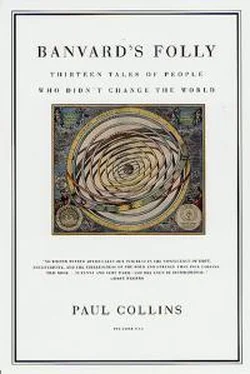Indeed, just about the only place you wouldn't find n-rays was in a dead body.
Although Blondlot found that the eye of an ox could store n-rays days after the ox had been butchered, experiments by Charpentier had shown that long-dead tissue did not store or give off n-rays. This gave one Lancet correspondent a way of disproving the theory that n-ray results were being caused by nothing but body heat. When not bathing live patients in n-rays at his office in Durham, Dr. J. Stetson Hooker also found a good use for n-rays on a dead patient:
I had some months ago the opportunity of trying to pass the rays through the forearm of a deceased patient some time after all the natural warmth had passed off .... Increased luminosity on the screen was soon apparent to myself and two eye-witnesses. Surely any heat rays would have been stopped on any attempt to pass them through this particularly cold stratum.
A reasonable-sounding argument. But then Dr. Hooker goes on to describe some further experiments on rays given off by humans:
I have conducted during odd moments of the last three years some 300
experiments to test this question of the human-ray spectrum and the extraordinary unanimity of the results is astounding .... Rays emanating from a very passionate man have a deep red hue ... the ambitious man emits orange rays; the deep thinker, deep blue; the lover of art and refined surroundings, yellow; the anxious, depressed person, grey; the one who leads a low debased life throws off muddy-brown rays.
It is hard to know whether Hooker had actually seen rays emanating from his patients. He does appear, however, to have discovered the precepts governing the Mood Ring.
Faced with a wave of evidence coming in from respected scientists and crackpots alike, John Butler Baker, writing from the Cavendish Laboratory,
simply threw up his hands. "I am at a loss to find any other explanation of M.
Blondlot's results," he said shrugging, "than that he has come across a radiation to which some men are blind and others not so."
The problem, Blondlot patiently reminded his colleagues, was that their eyes had to be sensitive and acclimated to the dark, and they had to be viewing the rays from precisely the correct angle--anyone standing off-axis to the rays'
plane of polarization might see nothing at all:
Only the observer placed exactly in front of [i.e., near] the sensitive screen perceives the effect of these rays. It also shows how illusory it would be to try to make an audience witness these experiments: the effects perceived by different persons, depending as they do on their position with regard to the screen, would certainly be contradictory or imperceptible.
Even if a few foreigners disagreed, any doubts in France about the importance of Blondlot's discoveries were silenced when he received a letter from the Acad@emies des Sciences on August 26, 1904. He had been awarded the Lecomte Prize, with a purse of fifty thousand francs and fame as his country's greatest physicist. There was only one prize left to secure: the Nobel Prize in Physics. Only three years old at this point, it had always been won by discoverers of radiation-Wilhelm Roentgen, Henri Becquerel, and the Curies.
Now it might be Blondlot's turn.
Over in England, things were looking glum. It was a September day in Cambridge, and a knot of physicists gathered in a corner of a meeting of the British Association for the Advancement of Science. None of them had been able to find n-rays in their experiments, and the news of Blondlot's award was weighing heavily upon them. Professor Rubens, visiting from Berlin, was especially exasperated. Kaiser Wilhelm had ordered a command performance of n-rays, and after two weeks Rubens had to call the Kaiser in utter humiliation and admit that he simply couldn't do it.
Rubens's gaze fell upon another visitor to the meeting--Robert W. Wood, who was spending the summer off from his usual post heading the physics department at Johns Hopkins University. Wood was a mischievous fellow-he'd gone on a joyride on the Trans-Siberian Railway while it was still being built, had swooped about in a glider before its design was remotely safe to life and limb, and had written a loony spoof of nature manuals titled How to Tell the Birds from the Flowers. He also happened to be a brilliant physicist.
"Professor Wood," Rubens said pleasantly, "will you not go to Nancy immediately and test the experiments that are going on there?"
Wood demurred. Rubens had been the most afflicted by the n-ray discoveries, after all, so maybe he should go. But Rubens persisted--it would look too impolite if he, who had been very graciously answered by Blondlot in his correspondence, were then to throw cold water on the fellow. An artless colonial like Wood would hardly have anything to lose.
"Besides," Rubens added helpfully, "you are an American, and you Americans can do anything."
Wood arrived at Blondlot's laboratory in the evening of September 21.
Blondlot was happy to see him; not too many foreigners made the trek hundreds of miles out of Paris to the University of Nancy, and the good professor was always delighted to show off his latest n-ray results.
Blondlot didn't speak English, though, so he and Wood decided to converse in the international language of physics--German. This left Blondlot free to make
confidential asides to his lab assistant in French, although Wood secretly knew enough French to make out the gist of their conversation.
The evening commenced with a simple demonstration. Blondlot painted some circles in luminescent paint on a card, and then turned down the gaslights in his lab. With the circles glowing faintly in the dark, Blondlot irradiated the glowing card with a stream of n-rays.
Do you see the change in luminosity? he asked in the darkness.
Wood couldn't see it.
It proves nothing, Blondlot insisted. Your eyes are not sensitive enough yet.
They had reached an impasse of sorts, and Wood decided that even if his eyes weren't sensitive enough to prove the existence of n-rays, then surely Professor Blondlot's were. Standing in the darkness of the lab, they tried a new test:
I asked him if I could move an opaque lead screen in and out of the path of the rays while he called out the fluctuations of the screen. He was almost 100
per cent wrong and called out fluctuations when I had made no movement at all, and that proved a lot, but I held my tongue.
He then showed me a dimly lighted clock, and tried to convince me that he could see the hands when he held a large metal file just above his eyes. I asked if I could hold the file, for I had noticed a flat wooden ruler on his desk, and remembered that wood was one of the few substances that never emitted n-rays .... I felt around for the ruler and held it front of his face.
Oh, yes, he could see the hands perfectly.
This also proved something.
The lab's red darkroom lights came back up, and the trio made their way over to the room where Blondlot kept his spectroscope. All the while, Blondlot's skulking assistant--"a sort of high-class laboratory janitor," Wood sniffed--was giving the American dirty looks. The assistant knew something was afoot, but he wasn't sure what. Blondlot, though, was blissfully unaware, and led Wood over to the spectroscope to show off his n-ray-refracting aluminum prisms.
The key to an n-ray spectroscope--any sort of spectroscope, in fact--is its prism. You need it to break the constituent parts of visible light into the bands of red, orange, yellow, and so forth. The aluminum prism in Blondlot's spectroscope did the same thing, except that it split n-rays into distinct wavelengths visible through a viewpiece to a graduated luminescent scale.
Using this instrument, Blondlot took a series of precise n-ray wavelengths as Wood looked on.
Читать дальше











